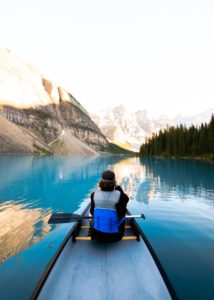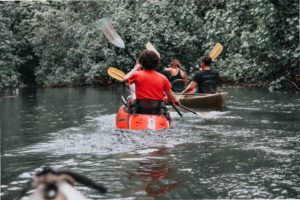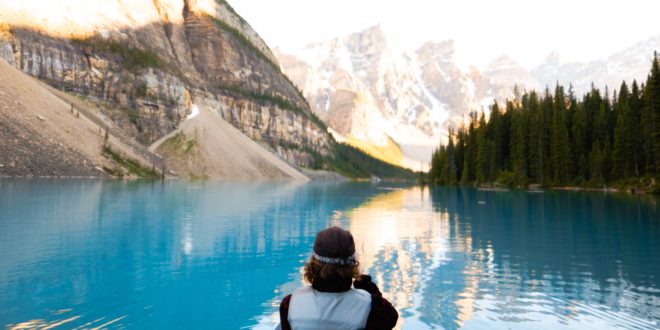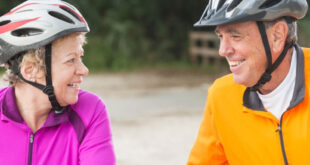Think that kayaking and canoeing are out of the realm of possibility for older adults? Think again. Check out this quick essential guide to getting your paddle on, no matter your age!
 What is the difference between canoeing and kayaking?
What is the difference between canoeing and kayaking?
Canoeing involves rowing an open, uncovered vessel on water with a single-bladed oar. Canoes are typically longer and narrower with room for multiple people. You can sit in this type of watercraft or kneel while you paddle and push yourself through the water.
Not to be confused with canoeing, kayaking, on the other hand, is a paddle water sport that involves sitting in a small buoyant boat with a covered deck that features a small hole for a single person. Typically, your extended legs and feet stay dry in a kayak as they are largely enclosed by the “deck” of the kayak.
Using one oar with paddle blades at both ends, you can alternate rowing from side to side to move forward, brake, turn around, and so forth. Kayaks are very nimble watercrafts and allow the user to traverse a waterway with great speed and agility.
Benefits of kayaking and canoeing
Low impact – both kayaking and canoeing are considered low-impact physical activities which means that they are ideal for older adults with joint pain. Often associated with arthritis, joint inflammation, pain, and stiffness can make exercising difficult. Kayaking and canoeing offer an alternative to jogging and other high impact activities by providing an effective cardio workout without overstressing vulnerable joints.
Strengthens muscles – kayaking and canoeing target moderate to intense exercise to the muscles that comprise your core, back, shoulders, arms, and chest. Strengthening these key areas can play a role in not just helping you maintain muscle tone but also functionally in preventing lower back pain, promoting good posture, and giving you strength to complete daily tasks like carrying groceries. You can also lengthen your torso and strengthen leg muscles too as you use them specifically in a kayak for helping you steer.
Inclusivity – one of the most beautiful aspects of kayaking and canoeing for older adults is that they can include people with mobility issues who may otherwise not be able to participate in fun outdoor exercises. Because your legs rest inside the watercraft and you use your core and upper body to maneuver it, kayaking and canoeing become accessible to older adults no matter their ability to walk or run on dry land.
Mental stimulation – in addition to engaging multiple muscle groups, kayaking and canoeing engage your mind. The act of remaining balanced, coordinating both sides of your body at once, and navigating a constantly moving terrain (a lake, river, seaside, etc) gives your brain a workout as much as it does your biceps. Depending on where and when you paddle as well, you can switch between an exhilarating thrill ride or a calm and meditative experience.
Uncovering adventure – discovering new and exciting adventures right where you live could reinvigorate your outlook on life (and save you major money). Forgetting taking expensive trips to add a little spice to your everyday life. Hop out to the nearest lake, river, or beach and hit the water in a kayak or canoe. You’ll discover new environments and unwrap a newfound sense of appreciation for where you call home.
Social interaction – while kayaking and canoeing on your own can guarantee you solitude and serenity with nature, paddling with other people can be fun, interactive, and great for beginners just dipping their toe in these types of physical activities. Social interaction has been shown to help ward off the numerous detrimental effects associated with social isolation like increased risk for dementia and depression.
 Getting started with kayaking and canoeing
Getting started with kayaking and canoeing
While it might seem like a bright idea to simply hop out to the nearest waterway and rent a kayak or canoe, you may be better served by first joining a group or club. You can learn proper paddling technique, become aware of safety precautions, gain access to proper equipment like life vests and helmets, as well as engage with a crew of like-minded adults who are as interested in staying active as you are.
It’s important to keep in mind that canoeing and kayaking do occasionally result in your vessel flipping over. If you have difficulty swimming, you will want to brush up first on that skill and talk to a knowledgeable instructor about best practices for handling a flipped kayak or canoe.
For older adults with advanced disabilities, it is worth asking around to see if there is adaptive equipment available that will allow you to still hit the waterways. Seating supports, paddle grips, and other helpful aids can make it easier for you to enjoy these watersports with ease.









Join the Discussion
Type out your comment here:
You must be logged in to post a comment.